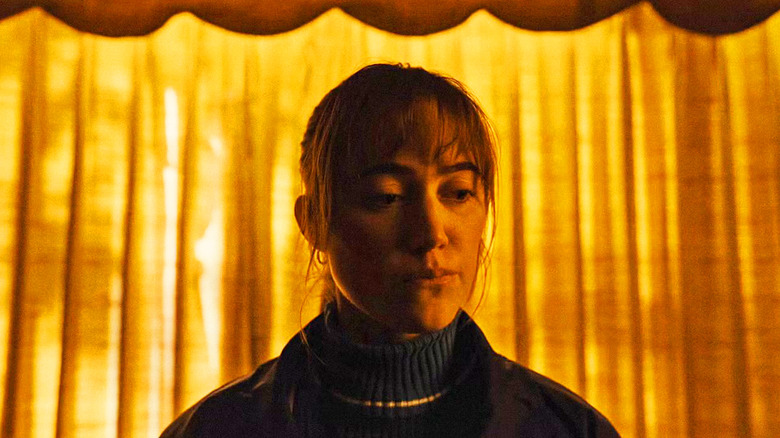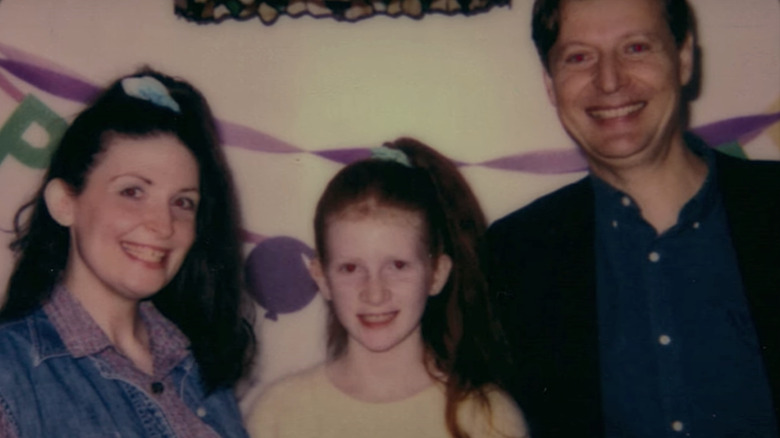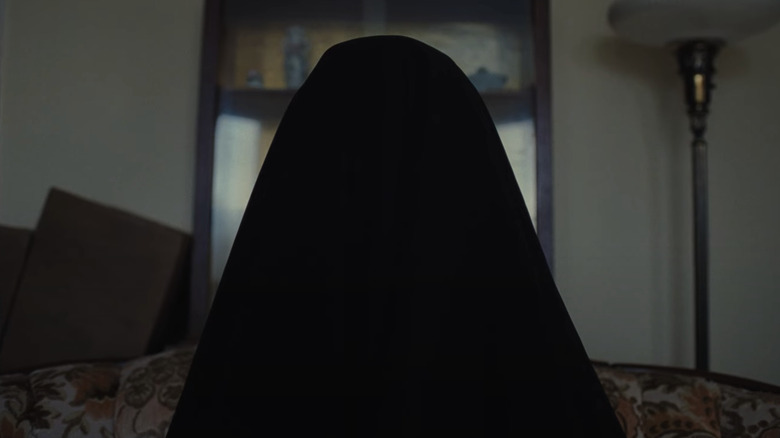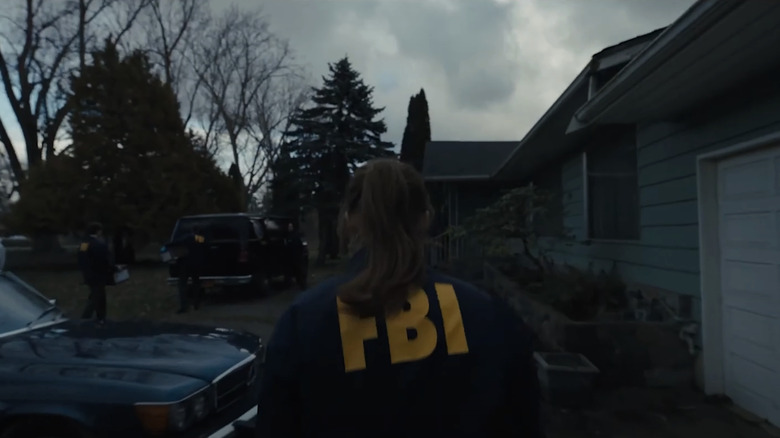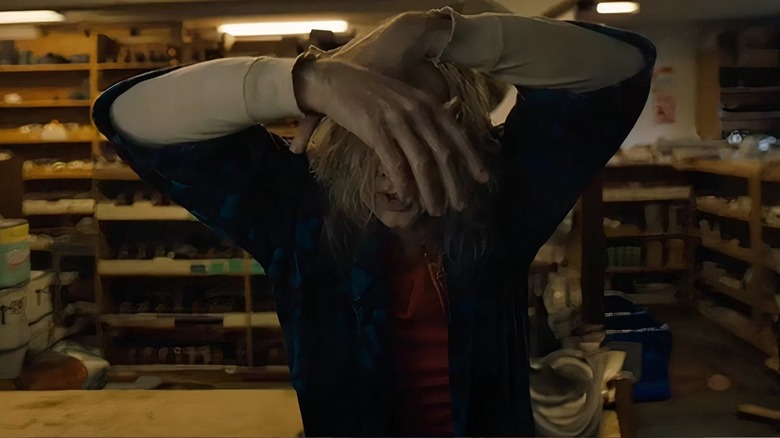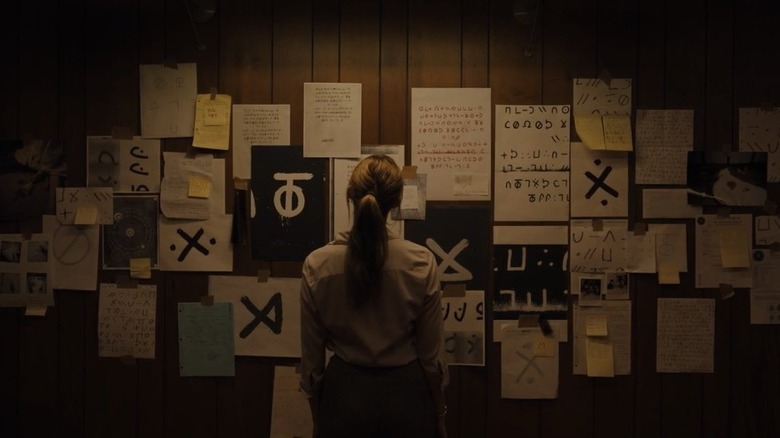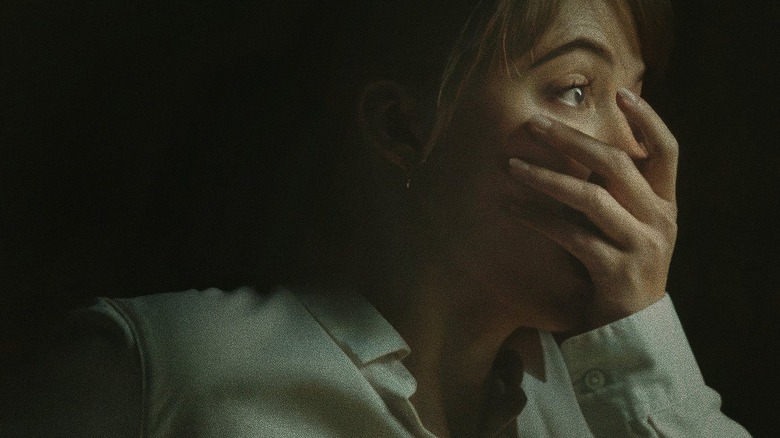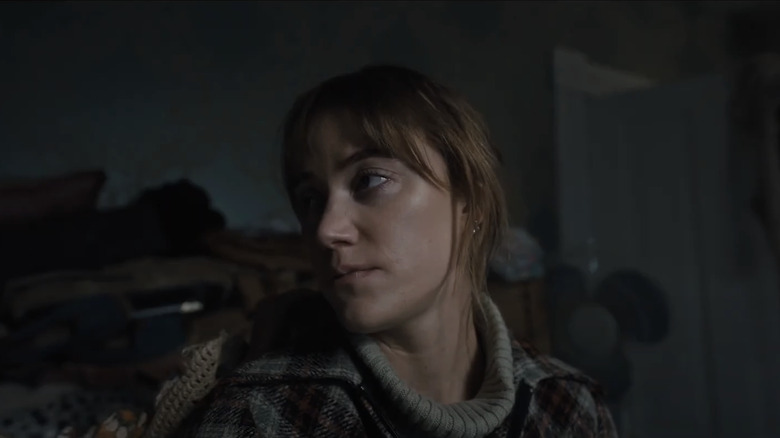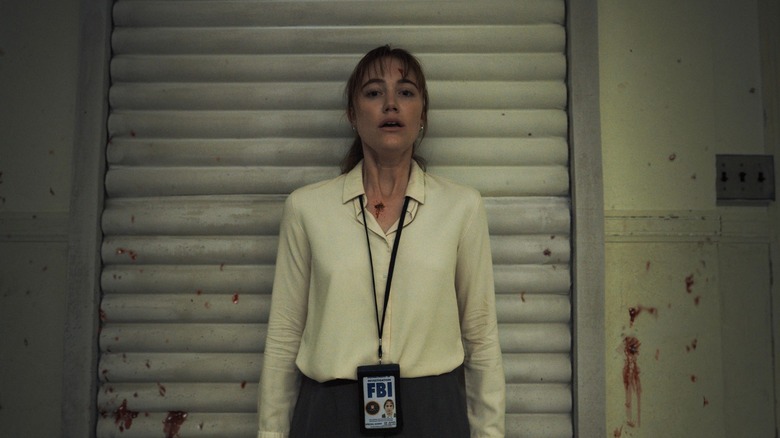How Do You Sell A Horror Movie In 2024? Longlegs Is Doing Everything Right
How many times have you seen a horror movie dubbed "the scariest movie of the decade" or "the scariest movie of the year?" In the YouTube and TikTok age, awarding a film with these infinitely flexible titles is now a standard part of a horror movie's marketing cycle. Even traditional media will use these designations, such as when we at /Film declared "Skinamarink" the scariest movie of 2023. We also said the same of "Talk To Me," but in fairness, that really was one of the year's more terrifying offerings. Obviously, none of these opinions are wrong, especially since they are just that: opinions. But in 2024, one film might actually have everyone in agreement on the most terrifying movie of the year.
"Longlegs" is a film from Osgood Perkins, the director who gave us one of the scariest A24 horror movies in "The Blackcoat's Daughter." Indeed, /Film's "Longlegs" review declared it the most terrifying horror movie of 2024, and it's not just us that feel this way. After the movie screened at Beyond Fest in May 2024, Twitter/X was flooded with reactions that extolled the film's atmosphere of unrelenting dread and yes, proclaimed it to be the scariest of the year. Soon after, outlets began reporting on how the new film was "making audiences cry."
Just as with the "scariest film of [fill in the blank]" title, we've heard this kind of thing before — movies that induce panic attacks, and have viewers fleeing theaters in terror. But "Longlegs" feels different. Even prior to the reactions, the movie's marketing helped establish it as one of the most oddly compelling horror films we've seen for years. In fact, I'd go as far as to say that the "Longlegs" promotion has been a masterclass of horror movie marketing.
NEON's mysterious Longlegs teasers
So, how do you sell a horror movie in 2024? Well, why not start by quietly uploading a series of obliquely-titled clips to YouTube and providing absolutely no context to explain them. That's exactly what NEON, the distributor for "Longlegs," did back in January of 2024. On the NEON YouTube channel, nestled between a teaser for "Robot Dreams" and the trailer for Sydney Sweeney's dour nun horror film "Immaculate," there sits a short clip ominously titled "Every year there is another." The video is just one long slow-zoom on a slide depicting a seemingly happy family while a 911 call plays out, accompanied by some of the most grimly discordant strings you'll ever hear. The clip ends with a line of obscure symbols that don't seem to tell us anything more about what's going on, while the video description simply repeats the title. And that was it. NEON just gave us this video and kept it moving.
What on earth was this terrifying glimpse into a nightmarish nether world? Did NEON make some sort of mistake adding this video to its official channel? Was the channel hacked? And why was this brief teaser scarier than 90% of full-length horror films? Well, seven days later, we got yet another unhelpfully-titled clip in a similar vein to the previous upload. This one was called "Remember to say your prayers." and it ended with one of the most deceivingly upsetting images yet seen in a horror movie trailer. But it wouldn't become clear why this image was so upsetting until the internet did its thing and revealed a whole new level of terror hiding in plain sight.
The horror hiding in plain sight
After the initial two clips appeared on NEON's YouTube, more arrived with names such as "Sweet" and "Dirty." But it was that final image from "Remember to say your prayers." that lingered in fans' collective subconscious. It showed what appeared to be a hooded figure sitting in a suburban living room. The stark blackness of the figure against the familiar homely environment was unnerving enough, but once Reddit got ahold of the image, things got downright freaky. One particular Redditor took it upon themselves to simply screenshot this final frame and enhance the brightness, revealing a demonic face with glowing eyes hiding just behind the hood.
NEON could have easily chosen to have the face slowly appear as "Remember to say your prayers." faded out. Instead, in stark contrast to the kind of jump-scare gore-fests that often dominate the horror space, the company gave fans the opportunity to look for the horror themselves, making it all the more chilling when it was eventually found. This also set a tone for whatever the film turned out to be — a movie where the horror is ever present even if you can't see it.
What's more, these teaser clips were the perfect inversion of the "show all the good parts during the trailer" approach that seems to otherwise dominate Hollywood movie marketing. Not content with simply leaving the teasers ambiguous, NEON was hiding the scariest parts right in front of us. That way, fans were spared from having the movie ruined and actively had to engage with the trailer in order to gain any sense as to what in god's name was going on.
The Longlegs marketing uses a central horror principle
It's a well known tenet of good horror movie-making that unseen horror is the most terrifying kind. Leveraging our collective "fear of the unknown," to put it crassly, remains the most effective way to petrify audiences en masse, and the best filmmakers know this. There's a reason director David Fincher chose not to show us what was in the box during that infamous "Seven" ending. But there's also a reason Fincher never showed us any of the actual "seven deadly sin" murders taking place. He knew that our imagination could conjure more horror than any visual depiction of the depraved acts in question. The "Lust" victim scene, for example, relies solely on the recollection of the poor dude forced to make use of a serrated sex toy. We don't actually see any of the act in question and the scene is all the more horrific for it.
Why, then, wouldn't a studio apply this central principle of horror movie-making to its marketing? It seems like such a simple move to make — keep the audience in the dark while teasing the horror that awaits should they dare venture into the multiplex. This isn't the same as A24's approach to horror movie trailers, where the marketing often doesn't match the movie being promoted, leading to disappointing audience scores. Rather, NEON's cryptic approach works well precisely because it feels in keeping with the tone and subject matter of a movie about a mysterious serial killer. Sadly, this is an approach too often overlooked in an age where trailers can't debut without a tortured social media-focused three-second pre-tease that shows the best part of the trailer before it's even begun. You know what really gets people to stop scrolling? "Remember to say your prayers."
The slow reveal of the Longlegs marketing
After "Remember to say your prayers.," NEON continued to deliver cryptic teaser clips. But this being the internet age, the company obviously couldn't keep things cryptic for too long. The movie being promoted was, of course, "Longlegs," the latest effort from Osgood Perkins. The director previously helmed the aforementioned "The Blackcoat's Daughter," 2016's "I Am the Pretty Thing That Lives in the House," and 2020's "Gretel & Hansel" — all of which maintain a slow-building sense of doom, delivering a measured dose of terror that stays with you long after viewing. But by the time the initial "Longlegs" clips had all hit YouTube, this latest film from the 50-year-old filmmaker looked to be a real crystallization of Perkins' approach — a full realization of the all-enveloping dread that the filmmaker seemed to command so well.
The reactions to early screenings all seem to speak to that idea, too. While the premise and tone of the teasers suggested a very "Silence of the Lambs" and "Seven"-esque vibe, "Longlegs" was clearly a more horror-focused movie. This was confirmed after early screenings prompted talk of a nightmarish vision that caused viewers to cry midway through. We also learned the film takes place in the 1990s and stars Maika Monroe as FBI agent Lee Harker, who's tasked with solving the case of a serial killer known as Longlegs.
At some point, we also learned Nicholas Cage would be portraying the titular serial killer. Once again, NEON had buried an aspect of the film that would usually be front and center of the marketing campaign — although depending on how you feel about Cage's acting, learning he's involved might have been too horrific a revelation. This is, after all, the man who ripped out his own teeth for an early role.
Longlegs pays homage to classic horror marketing
Talk of audiences losing their composure during screenings are nothing new when it comes to horror movie marketing. Part of the reason Damien Leone's "Terrifier 2" fared so well at the box office in 2022 was down to reports of audience fainting, vomiting, and even leaving screenings in ambulances. The optics, as they like to say, were perfect. "Terrifier 2" was seen as too brutal for even seasoned horror fans, and as such represented a challenge to those very fans. But again, this is hardly the first time this sort of thing has happened.
The idea that these films cause physical harm has been seen as a real USP for purveyors of horror throughout the history of cinema. All the way back in the 1950s, director William Castle actually offered audiences a $1,000 life insurance policy against "Death by Fright" for his 1958 film "Macabre." Hardly the same as using vomiting as a reason to watch a film, but the same principle nonetheless.
In the case of "Longlegs," you see the same thing but a much more tastefully restrained version. What's more, reports of the film inducing some torturous physical reaction seem a lot more organic. Claims of the very atmosphere of "Longlegs" being enough to create a palpable sense of terror are much more widespread and coming from reputable sources such as this fine website itself. As such, you start to believe in the unique terror this film promises.
A horror marketing masterclass
Since the initial "Longlegs" clips arrived online, NEON started applying the "fear of the unknown" principle to its other marketing efforts, erecting cryptic billboards around the country with similarly ominous symbols that revealed nothing about what was being promoted. You can also see this shrewd awareness of the power of keeping things eerily vague in the official posters for the film. One example simply shows star Maika Monroe as FBI agent Lee Harker, gripping the gun on her waist and covering her mouth in horror as she recoils from what we can only imagine is some obscene murder tableau. Again, we don't see the actual source of the horror, and the poster is all the more effective for it.
As the trailers rolled on, NEON got more comfortable showing us more of the movie. A more recent trailer revealed that grim visage behind the veil in full. There's also an in-universe website mimicking an early-internet aesthetic, and a phone number fans can call if they want to get creeped out in particularly personal fashion. But even as the "Longlegs" release date fast approaches, if all you've seen are the billboards, the posters, and the trailers, you'd still probably have only a vague idea of what the movie is about. That doesn't matter, though, because you probably have a clear idea of how the film feels and that's really the genius of the whole campaign.
I haven't been as excited for a horror movie for years, and I know as much about the plot as the official synopses have revealed. Buoyed by reports of screening audiences weeping in the face of unending dread, the "Longlegs" marketing really has been a masterclass on how to sell a horror movie in 2024. But there's more to it than that.
Films feel different in 2024
In 2024, very little is mysterious. The social media age, where everybody is eager to present the best versions of themselves and share every aspect of their lives, has slowly eroded the lines between us, the media we consume, and the people who make it. This has only been exacerbated by the so-called democratization of information — none of which is necessarily a bad thing. Artists and fans are more connected than ever, and there are obvious benefits to that. If I want to know how my favorite band plays a song, for example, I can just go to the guitarist's YouTube for lessons on how to play the riff. Similarly, back in 2019, had Paramount not released the original trailer for the exhausting video game adaptation "Sonic the Hedgehog" online, and had fans not reacted in outrage to the bizarre redesign of the titular character's eyes, we might well have had to live with this needlessly horrifying version of the beloved hedgehog running rampant at the box office.
But there is also a cost to this erosion of the barrier between audiences and the media they consume. Leaving aside the obvious pitfalls of having fans dictate the direction of artistic endeavors, there's also this feeling that everything is more attainable, and therefore less special in a time of Ultra HD resolutions, streaming abundance, and ubiquitous interconnectivity. What's exhilarating about "Longlegs" and NEON's approach to the marketing is that it represents a salve for these very issues.
Longlegs is more than a scary movie
Growing up in the 90s, movies felt more special — like transmissions from a mysterious, just-out-of-reach dimension. If you saw a trailer for a movie, you couldn't look it up online and immediately discover everything about it. There were no "everything we know" articles to break down the minutiae of a movie before it was released. There weren't a dozen similar streaming films available for instant binging. You just had to wait for the next transmission from Hollywood. Adding to the allure was the simple fact that films used to be shot on celluloid. The mere presence of film grain gave movies this sense of existing behind a faint veil, as if we were peering into an otherwise inaccessible fantasy world. It all played into the fact that films are fantasies realized and, when done right, can be pure magic.
All of this is to say that the "Longlegs" marketing evokes memories of a time when movies felt this way. This isn't some golden age syndrome-induced rant about "the good old days," either. Anyone interested in culture will have surely noticed a burgeoning nostalgia for a time when media, and perhaps things in general, just seemed to possess a little more magic. You can see it in the weirdcore-inspired, dark nostalgia aesthetic of "Skinamarink" and feel it in the mournful, elegiac wistfulness of "Aftersun." It's also perhaps not a coincidence that "Longlegs" is set in the '90s.
There might not be much wistfulness to the doom-laden "Longlegs." But that same appreciation for tasteful restraint and an awareness of the power of the unknown is at the heart of the marketing campaign. So, "Longlegs" might well be the "scariest film of the year." But in a strange way, it might also be the most reassuring.
"Longlegs" opens in theaters on July 12, 2024.
